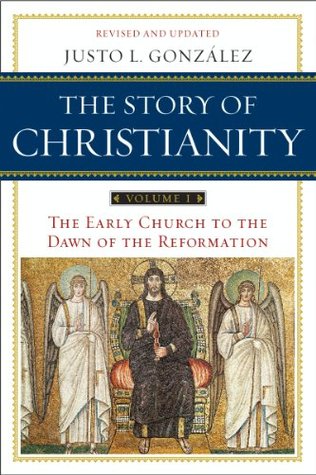More on this book
Community
Kindle Notes & Highlights
Read between
February 22 - March 5, 2020
Like it or not, we are heirs to this host of diverse and even contradictory witnesses. Some of their actions we may find revolting, and others inspiring. But all of them form part of our history. All of them, those whose actions we admire as well as those whose actions we despise, brought us to where we are now.
Thus, the practice arose of translating the sacred text into Aramaic, at first orally, and then in written form—in documents known as Targums.
At some point around the second century, a Syriac translation of both the Old and New Testaments appeared, and came to be known as the Peshitta—(peshitta means “simple”), which thus reminds us of Vulgate, which has a similar meaning.
Tatian—the disciple of Justin Martyr who has already been mentioned as one of the early apologists—had attempted to harmonize the four Gospels into a single one, taking some elements from each, and leaving out others. This edited compilation of the four Gospels was known as the Diatessaron—meaning “according to the four”—and was the subject of much controversy among Syriac-speaking Christians, for some preferred it to the four canonical Gospels and others rejected it altogether—a controversy that was not quickly resolved, for the Diatessaron was still read in some Syriac churches as late as
...more
The outstanding Christian leader of the entire history of the Visigothic kingdom was Isidore of Seville. He was a scholar who sought to preserve as much as possible of ancient culture. His book Etymologies is a veritable encyclopedia that shows the state of knowledge at his time, not only in religious matters, but also in astronomy, medicine, agriculture, and practically every other field of knowledge.
One of these, Charles Martel (that is, “the Hammer”) led the Frankish troops against the Muslims, who had taken Spain, crossed the Pyrenees, and threatened the very heart of Europe. He defeated them at the battle of Tours (or Poitiers) in 732.
This was of paramount importance for the subsequent history of Christianity, for Pepin’s son, Charlemagne, would be the greatest ruler of the early Middle Ages, one who sought to reform the church, and who was crowned emperor by the pope.
The most famous of these missionaries was Columba, who settled on the small island of Iona with twelve companions, probably in 563 ce. The monastery that they founded there became a center of missions to Scotland, where there soon were several other houses patterned after the Iona community. Eventually, these missions moved south, to territories held by Angles and Saxons.
It is also interesting to note that the popular hymn “Be Thou My Vision” is a translation of a Celtic prayer or lorica to thwart the evil influence of the Druids—Rob tu mo bhoile.
It was thus that Boethius, the most learned man of the time, was put in jail by King Theodoric. While in prison he wrote his most famous work, On the Consolation of Philosophy, which debates predestination and free will, as well as why evil men prosper while good men are ruined. In 524 he was executed, jointly with his father-in-law Symmachus.
In summary, from the fifth to the eighth century Western Europe was swept by a series of invasions that brought chaos to the land, and destroyed a great deal of the learning of antiquity. The invaders brought with them two religious challenges that until then seemed to be matters of the past: paganism and Arianism.
Eventually, both pagans and Arians were converted to the faith of those whom they conquered. This was the Nicene faith, also called “orthodox” or “catholic.” In the process of that conversion, and also in an effort to preserve the wisdom of ancient times, two institutions played a central role, and thus were strengthened. These two institutions, to which we now turn, were monasticism and the papacy.
This Western monasticism, however, tended to differ from its Eastern counterpart on three points. First, Western monasticism tended to be more practical. It did not punish the body for the sole purpose of renunciation, but also to train it, as well as the soul, for a mission in the world. Columba and Augustine of Canterbury are examples of this practical bent of Western monasticism. Secondly, Western monasticism did not place the premium on solitude that was typical in the East. From the beginning, Western monasticism sought ways to organize life in community. Finally, Western monasticism did
...more
Benedict’s greatest significance, however, was in the Rule that he gave to his community. Although fairly brief, this document would determine the shape of monasticism for centuries. Rather than extreme asceticism, what the Rule seeks is a wise ordering of the monastic life, with strict discipline, but without undue harshness.
There are, however, two elements of the monastic life that are crucial for Benedict. These are stability and obedience. The first means that monks are not free to go from one monastery to another as they please. Each monk must remain for the rest of his life in the monastery that he has initially joined, unless ordered to go to another place. The commitment to stability on the part of Benedictine monks proved one of the sources of the institution’s great relevance in a time of chaos. Secondly, the Rule insists on obedience. First of all, this means obedience to the Rule itself. But the abbot
...more
In 732, they were finally defeated by Charles Martel at the battle of Tours, which marked the end of the first wave of Muslim expansion.
But there were still other issues that would cause sharp theological disagreement. Foremost among these was the question of how divinity and humanity are joined in Jesus Christ. This is the fundamental christological question.


